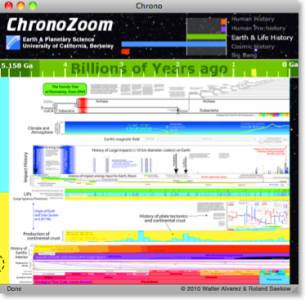Seeing the Big(gest) Picture with ChronoZoom

For every action, a reaction. As a counterweight to the vogue for the micro-historical and sub-sub-specialization that developed over the 20th century, an enthusiasm appeared in or about the 1980s for sweeping geologic and evolutionary narratives that reached back in time to restore the chronicle of human affairs to its proper place in a much, much bigger picture. Appropriately, some practitioners of the new interdisciplinary mega-synthesis came to call their project Big History. The name has endured.
The whole premise of Big History is predicated on using the tools of science for the telling of history, and not surprisingly, many of the most successful researchers associated with the idea have strongly interdisciplinary backgrounds with training in the sciences (think: Jared Diamond, UCLA Professor of Geography and Physiology, ace orinthologist, bio-geographer, linguist, and Pulitzer winner for Guns, Germs, and Steel). What’s more, new digital technologies are giving the science-history synergy of Big History an added impetus and some visual dazzle. This is not unlike the idea that with Peter Jackson and CGI, technology had finally caught up with the vision of J.R.R. Tolkein.
Witness the new ChronoZoom program developed by Roland Saekow and Walter Alvarez of Berkeley’s Earth and Planetary Science Department with the Microsoft Live Lab’s Seadragon Deep Zoom technology. The program, a true Big Historical effort at “bridging the intellectual chasm between humanities and sciences,” presents a scrollable, zooming, and panning “master timeline” that visually situates human history within geologic and galactic time. The stated aim of the project is a synthesis of historical regimes—cosmology, astronomy, geology, paleontology, evolutionary biology, archaeology, and historiography, but the real uniqueness (and what makes the program both fun and fascinating) is the technology.
Rather than a standard simple timeline that spools out along a single access, left-to-right, ancient times to the present, ChronoZoom essentially works in three dimensions—the standard x-axis chronology, a y-axis stacking of the various “historical regimes,” and a z-axis that puts the “zoom” in ChronoZoom and allows the user to take in the big picture and visually apprehend the totality of human events as a blink of the galactic eye. As the program’s developers point out, the inability to re-scale a traditional timeline results in a severe loss of “resolution in the information” it can display at any given scale.
As the ChronoZoom tool is built up to include more detail (on every time scale), the utility for the classroom as a means of representing the inter-related and even interdependent chronologies of human, nature, and planet will increase commensurately. At present, the datasets that populate the timelines are a little uneven and seem much stronger on natural science information than human history.
But that could just be the gripe of a confessed humanist.